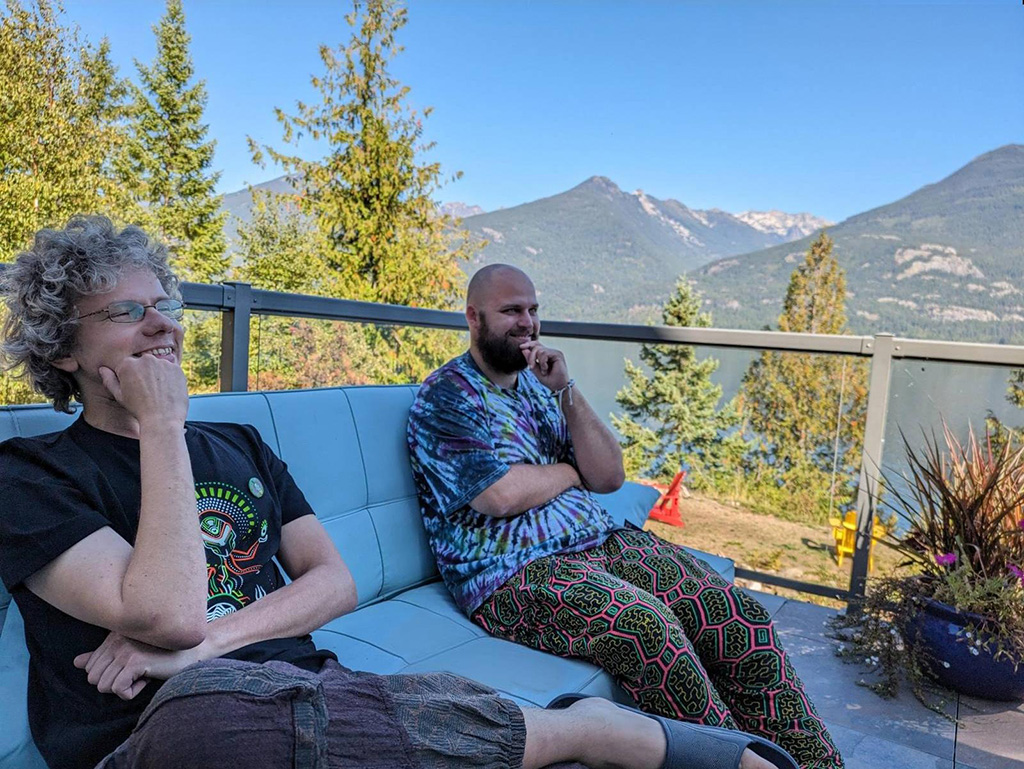The big picture
There are three things which motivated the HEART project:
1. Epistemic potential energy
If you map out how information flows out of states of consciousness and into scientific models and publications, you will see that there are a lot of missed opportunities. An extreme example of this is how at a well known psychedelic research center – at least at one point in time, they would officially discourage their researchers from discussing their own psychedelic experiences in public.
More broadly, we have an issue whereby these days there are a lot of people doing exploration with psychedelics and meditation – and the way in which their phenomenology gets out is through trip reports, or psychedelic drug replications. However, if you look at the literature, there might be some conception of phenomena like tracers and different classes of hallucinations and suchlike – but there’s no detail. Of course, there’s a paradigmatic and sociological aspect to this. Back in the sixties, psychedelics led a lot of really interesting people to flunk out. From the point of view of academia, this was a kind of Black Plague – or at least that’s how my professors at Stanford used to talk about it – and the survivors developed memetic resistance against it.
So, selection effects mean that academia doesn’t take observations about consciousness too seriously. Even when you go to a psychedelic science conference, you might find people having detailed, elaborate discussions about their phenomenology – but the things you see in posters and presentations tend to be very basic questionnaire-based studies. It feels to me like there’s a very large amount of epistemic potential energy, here.
2. Structural phenomenology
In addition to epistemic inefficiency around phenomenology, academia also lacks an emphasis on studying phenomenology from a structural, mathematical, or even computational perspective. It’s rare, and there are some people thinking about subjective experiences computationally – for example, those working on predictive processing theory – but it doesn’t seek to model the details of our phenomenology, especially not the most exotic ones. In contrast, when I began analyzing trip reports all the way back in 2016, I found myself studying complex hyperbolic geometry and complex mathematical relationships of all sorts. I then then started receiving emails from people who all shared the same sentiment: Hey, I see the connections you’re making here. I think there’s a lot of rich mathematics to explore.
So, it felt to me like the opportunity here was to find the people who could say meaningful things about the more nuanced, mathematical properties of experience, and bring them all together. Our recruiting process focused on three main categories:
- People who are attained meditators, especially those with high phenomenological clarity and who are curious about their experience.
- People who have created good replications of exotic states of consciousness, especially those who are highly regarded in their field.
- People who have a strong background in mathematics, computer science, and especially physics, who can help provide a theoretical grounding to our observations.
We had other criteria for inclusion, such as high equanimity, substantial experience with psychedelics, and technical, artistic, and communication skills.
3. A dojo for psychonauts
Our final motivation for creating HEART was the idea of creating something like a dojo for psychonauts: A place where we can collectively come up with the conceptual frameworks and methodologies for making the most out of experiences, both from the perspective of raising baselines as well as extracting the most phenomenological juice out of them.
In particular, this last part is what motivated a daily meditation practice in order to slowly distribute a repertoire of conceptual frameworks which we could use as a shared language. I’m very welcoming of people’s frameworks, and part of the idea is that we get to explore everybody’s intuitions and try to connect them with one another.
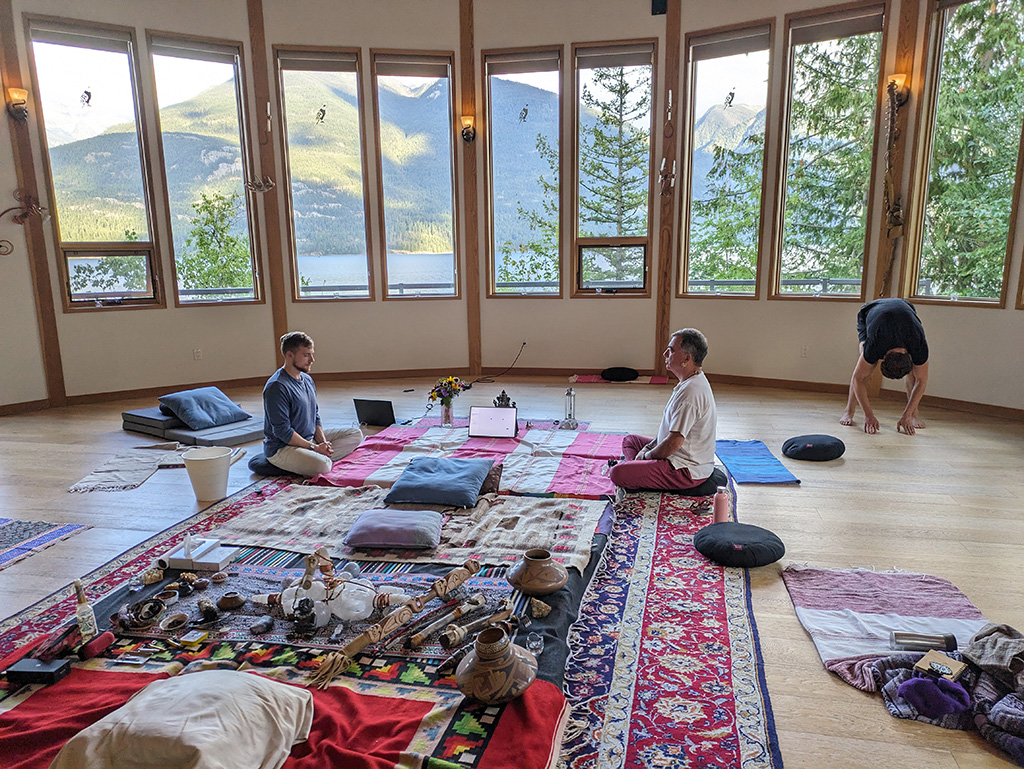
Deeper background
There are some deeper background assumptions which we work with, namely qualia formalism and valence structuralism. We also orient towards three deep goals of the Qualia Research Institute, which are:
- Getting rid of intense suffering
- Increasing baselines
- Achieving new heights
For this reason we put an emphasis on figuring out the nature of higher valence experiences. We also emphasize studying the phenomenal character and structure of experiences over their intentional content, because we think that’s where we think we’ll find the most useful information upon which we can build a theoretical foundation.
Semantic content is already widely explored in the literature, and while studying semantic content might help us understand how, for instance, such things might heal trauma – beyond interpreting things from a metaphorical, symbolic, or personal historical point of view, we encouraged participants to use their unique talents and the synergy of the group to think in technical and mathematical ways about their experiences.
Of course we recruited from a pool of people who already are curious about their phenomenology in their own unique way, and we simply made sure there would be genuine interdisciplinary overlap between participants to enable communication bridges. This way each participant would have multiple ways to collaborate with other participants in a way that emphasizes understanding the laws of phenomenology rather than simply digging into an existing semantic landscape.
Retreat themes
Insofar as the retreats had themes, in Brazil we focused on higher dimensions and hyperstereoscopy. We also did some work on psychedelic cryptography, and the final theme was harmonic resonance.
Then in the Canada retreat, in addition to these things the theme was whether or not we can decode the formula for a plus-four experience, going by the Shulgin Rating Scale. Under what conditions do such states arise? 5-MeO-DMT has a reputation for generating plus-four states, and it seemed like a very good opportunity to explore these more carefully.
A research heuristic which we started with was that of exploring state spaces in efficient ways. In collaboration with a friend from back home, André Silva – and two interns, Adam Grzelec and Diego Blanco – we spent some time before the retreat creating animations which we could not only study and report on what was experienced, but also interact with and change the underlying parameters until we found something which – to quote Symmetric Vision – looked kinda fucky.
This task was very broad – it’s just to look for things which are strange. It’s not even defined to the point where it’s like, let’s investigate this color or textural phenomenon – it’s more about exploring a state space and finding what interesting phenomena it contains. As one example, this process allowed us to discover a stimulus which appears to move while on a psychedelic but remains mostly static while sober. Of course, many things look like they are moving while on psychedelics – but in this case the animation is in fact moving, and the psychedelic-enabled perception can be more accurate when it comes to rendering the movement than the sober one. This requires a lot of parameter tuning and experimentation, which this paradigm makes it really easy to do.
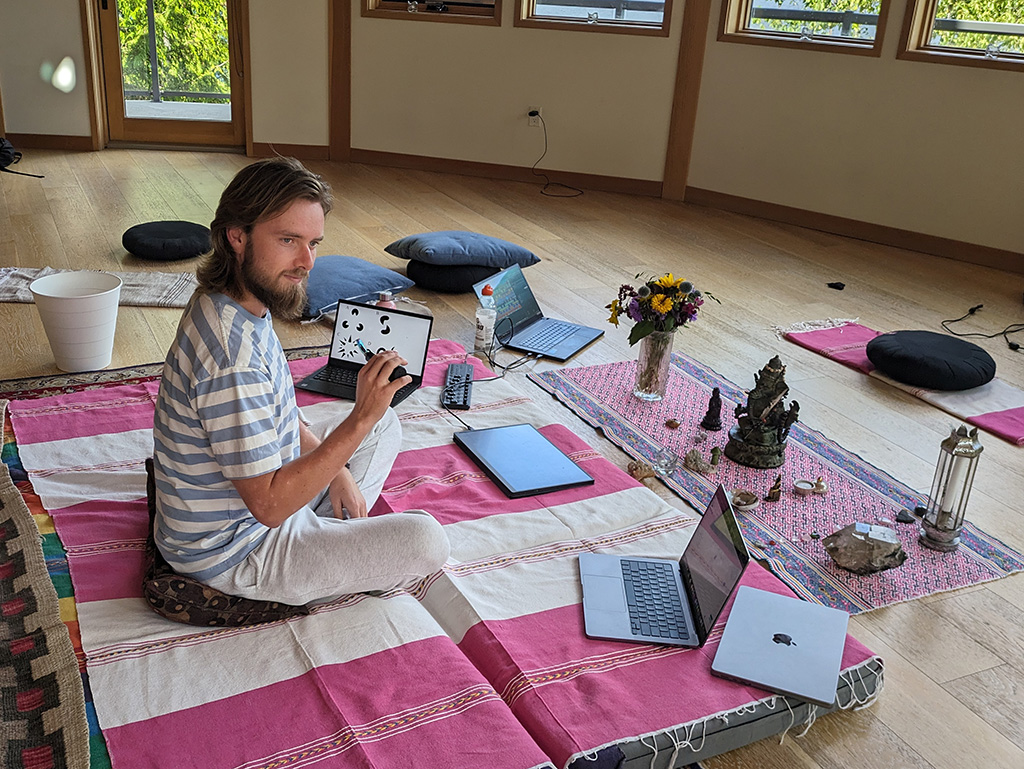
Something else we studied while in Brazil was the how as a dose of mushrooms increases the complexity and dimensionality of hallucinations also increases. With Symmetric Vision’s visualisations we were able to demonstrate how the gestalts formed out from these rotating transverse waves becomes more and more interconnected and elaborate – and you can just about quantify how large they are as a function of the dose. We theorise that this state enhances cross-frequency coupling.
Retreat structure
We structured the retreats so as to cultivate a sense of balance. We had three types of days:
- Experiment days, where mostly people were experimenting or trying to help out with experiences one way or another.
- Startup days, where some of us would work on various projects, while others would coordinate across the team so everyone was aware of what others were working on and make themselves available to help others with their research.
- Rest days, where people worked to the extent that they wanted, but were also 100% free to just meditate all day in the woods, or go check out the town – whatever they wanted to do. We also organized some hikes, and went to some hot springs.
The point was that this was kind of a mixture of a vacation, a spiritual retreat, and a hackathon. The startup days felt really awesome, like spending time with amazing coworkers – everybody in the zone working on visualisations or theorizing about how to apply things like field topology and geometric frustration.
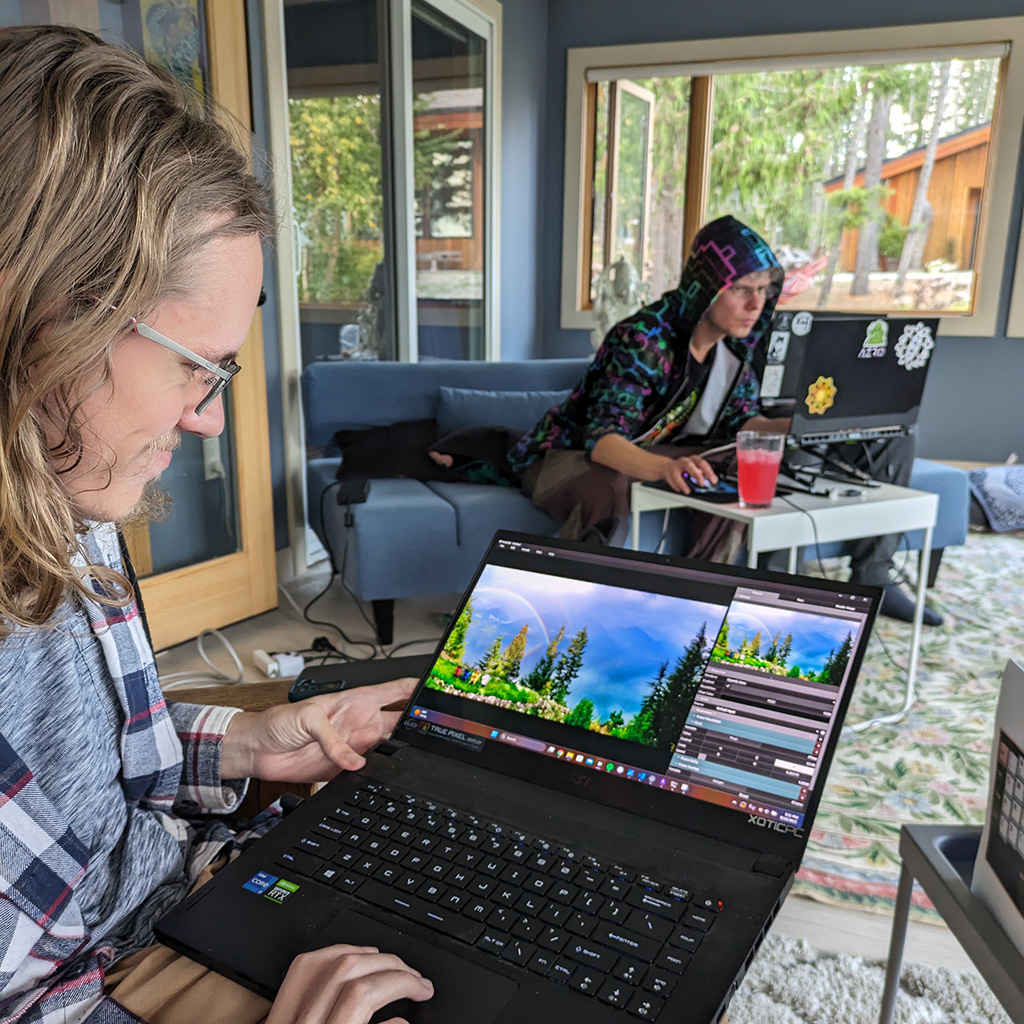
There was a lot of incredibly cool stuff that people were working on. It felt very much like there was nowhere else in the world that exists where people are so deeply engaging with their experiences – and then using code and math to produce things in real time to show to each other, and building upon each other’s work. So one of the things that was the most enriching was just seeing the synergy, the amazing quality of people’s work, vibes, everything.
Editor’s note: I reminded Andrés of a video he showed us in Brazil – of Ralph Abraham’s work back in the eighties using computer graphics to render psychedelic visuals. I felt the hackathon days were very much in the lineage of what Ralph was trying to achieve at Esalen. His videos required large supercomputers to render – much less convenient than working with Scry, Symmetry and Rudolfs with their big laptops and GPUs! It very much feels like the time is finally right for this kind of project.
Each day we also included a skillshare session – where people would have the chance to spend half an hour sharing something from their field which they have a deep understanding of – whether it be how to make a replication, how to cut a Möbius strip in half, or even career advice – what are you wise about that you want to share?
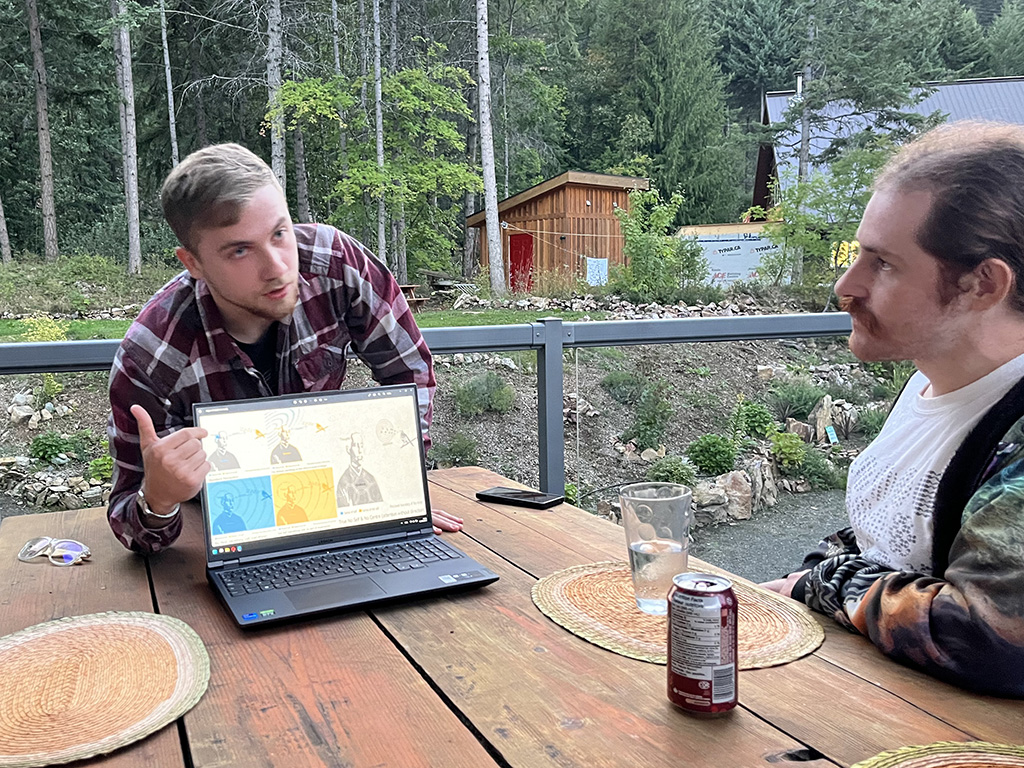
Future retreats
All of this exploration felt like prototyping processes for future exploration – everything from how to conduct the research, how to manage a group, ideal relaxation before a trip, how to process experiences. I think as a whole it seems both very scalable as well as worth scaling – ideally in a place where we can be there for the long term and know everything about the place, so it gives us a strong sense of stability in the location.
My sense is that phenomenological awareness is getting more widespread, and the recruiting pool is increasing all the time. Even things like jhāna practice going mainstream should be helping create a cohort of people who are experienced with altered states, have developed some equanimity and are curious about it in a technical way.
If you are interested in contributing in some manner or in participating in a future retreat, please don’t hesitate to get involved.
